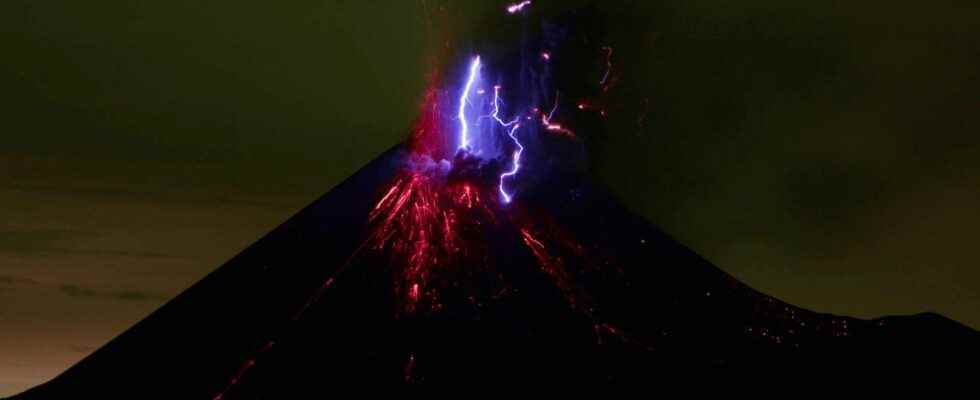You will also be interested
[EN VIDÉO] How does magma form before a volcanic eruption? Magma is the origin of the formation of volcanoes. This molten rock, which bubbles up in the crater, comes from a partial melting of the Earth’s mantle. Futura met Jacques-Marie Bardintzeff, doctor in volcanology, who tells the origin of magma.
One could imagine that this third eruptive phase of the year was going to be similar to the previous ones, with emissions discreet ashes for a few days before a return to calm. But the activity intensified this weekend, without that being a surprise either. Indeed, the appearance of lights at the level of the vent during certain explosions suggested that the water around the eruptive mouth, which is around sea level, had largely evaporated due to the heat of the eruption. Fact, the magma then interacted less with water and more magmatic, less phreatomagmatic activity could take place. The incandescent projections expelled during the explosions that took place on the night of April 21 to 22 went in this direction…
Terjadi #erupsi G. Anak Krakatau pada hari Jumat, 22 April 2022, pukul 02:37 WIB dengan tinggi kolom abu teramati ± 1500 m di atas puncak. Erupsi terekam di seismograf dengan amplitudo maksimum 60 mm dan durasi 45 detik. #PVMBGhttps://t.co/aOEHggFxZJ
—PVMBG (@PVMBG_) April 21, 2022
Explosion at 2:37 a.m. local time on April 22, with incandescent projections and a column of ash 1,500 meters high.
The eruptive activity then became purely magmatic and globally continuous, with Strombolian explosions projecting fragments glowing several hundred meters high and forming columns of ash 3 kilometers high! The “roar” of the volcano was heard up to 60 kilometers away at times!
These incandescent projections fall around the eruptive mouth and build a eruptive cone which can be noticed on the images of one of the webcams of this volcano. If the eruption lasts some time, it could also become the new summit of the volcano, which currently culminates at 157 meters above sea level. A lava flow can also be noticed by the plume of steam it generates, a sign of its arrival in the ocean.
Strombolian activity on the evening of April 22.
Two volcanic plumes on the morning of April 24: a column of ash generated by Strombolian activity, at the base of which we can make out the cone under construction, and a plume of steam indicating the arrival of lava in the ocean.
Consequently, theorganization in charge of monitoring this volcano decided to go to alert level 3 on April 24, with a ban on access within a radius of 5 km compared to 2 km previously.
New eruption of the Krakatau volcano in Indonesia!
Article of Ludovic Leducpublished on April 20, 2022
For the third time this year, the famous Indonesian volcano Krakatau erupted on April 15! After his collapse impressive at the end of 2018, at the origin of a tsunami which claimed more than 400 victims, the volcano resumed its cycles of construction…
This new eruptive phase begins on April 15, with a first plume of ash from 700 meters high. Some similar explosions then occur, then the activity increases on April 17 to become almost continuous. On April 18, it forms a column of ash that varies in height, up to two kilometers high, as in the previous eruptive phases of this year (February 3-6 and March 24-30).
At times during the night, a glow can be noticed at the rash mouth. This indicates significant temperatures which could indicate that the area around the vent is then dry. Indeed, this one being around the sea level, it is probable that the first explosions are the consequence of the contact between the magma and the sea water. But with time, it seems that the heat of the magma allows this water to evaporate, for less and less phreatomagmatic explosions…
Time-lapse of activity on the night of April 18-19. The glows are remarkable from 25 seconds.
Destructive events and construction phases
L’history of this volcano alternates long construction phases and destructive, brief and violent events. In 1883, for example, the Krakatau mountain collapsed into the sea, causing an impressive tsunami that claimed at least 36,000 lives! Then, activity resumed in the middle of the underwater crater formed in 1883 and a cone eventually emerged in 1927. Anak Krakatau, literally “Krakatau’s child”, was born. Over the following decades, this cone grew and reached more than 300 meters high. But the December 22, 2018, the volcano collapsed again, generating another tsunami that killed more than 400 people. Since then, eruptive activity has resumed and gradually rebuilt the volcano.
Anak Krakatau on January 11, 2019, shortly after its collapse! All that’s left is a flattened island… and the eruptive mouth is under water, at a shallow depth. © Earth Uncut TV
Support your independent scientific media: discover our subscription formulas!
4 good reasons to subscribe to Futura on Patreon:
- A site without any advertising from 3.29 euros per month.
- It is without commitment.
- Access to priority content, in preview, just for you.
- You support our business in the best possible way. A real motivation for us!
Interested in what you just read?
